© www.utopianature.com 2017-2022
All Rights Reserved
We have 'piped-in' a few photos from around the website to help illustrate the list, as well as added some new ones not otherwise up before. Not all bird photos used here were taken at the park, however they are all local to the Utopia area.
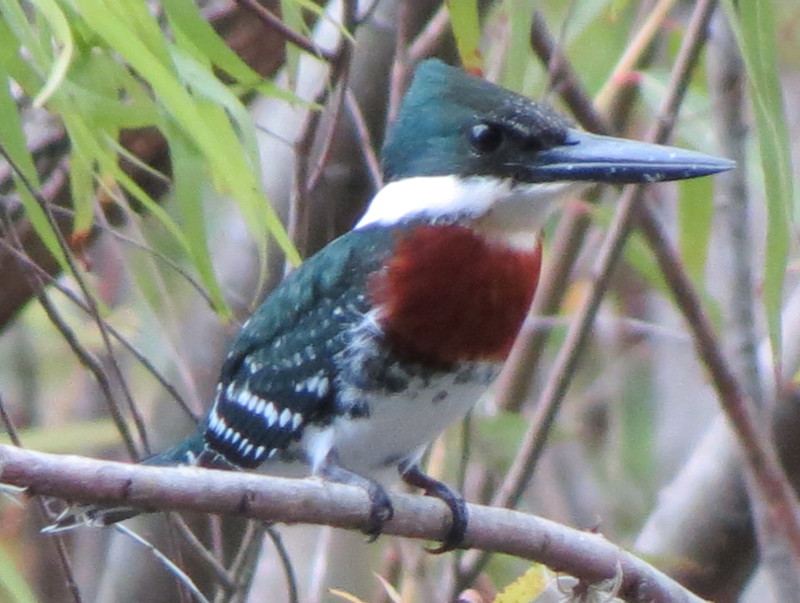
Male Green Kingfisher at Utopia Park
PREFACE
Primarily this is a list of the bird species known from Utopia Park. In addition there is much discussion to hopefully help understand various aspects of the park's natural history better, especially its avifauna. There are some mediocre photographs to help illustrate the sleep-inducing text. First we will torture you with more than you wanted to know about the how and why of birds at the park, and then about time you fall asleep, the bird list will appear. Or you can just scroll through the discussion, look at the photos, and go straight to the meat, the bird list. Without any explanation and context, a simple list of names provides little information. The bird list proper has for each species an indication of seasonal status and abundance, nesting status, and often but not always, date annotations for rare bird records.
WARNING: It is a long read. A veritible excercise in verbosity, it may take a few sittings to get through. Maybe bookmark it? Quick before the soporific effects set in. Some ideas about bird occurrences here may be familiar from other parts of the website, however we wanted this to be a stand-alone complete work, especially relating to factors influencing various birds occurrence at Utopia Park.
ACKNOWLEDGEMENTS
My thanks to several locals for help filling in the blanks and pointing me in the right direction getting some park details and information: Morris Killough, Valerie Moore, George LaRue, Lou and Marsha Jo Sheedy, Syd and Jackie Chaney, and Little Creek Larry were all very helpful. Thank you all very much! Errors, omissions, and poor grammar are the sole fault of the author, who welcomes any corrections or additional information of value. The digital nature of this work should allow for easy updates. Thanks also to my wife Kathy who did lots of work with the web script part, so you could see this.
LOCATION
Utopia Park is at the southwest corner of greater-metro Utopia, which surprising all oddsmakers turned out to be in northeastern Uvalde Co., in south-central Texas. Roughly around 60-65 air miles WNW of San Antonio. Utopia is on the southern edge of the Edwards Plateau, in one of the Balcones Escarpment river drainages that pour out or off of it.
Courtesy of GoogleEarth:
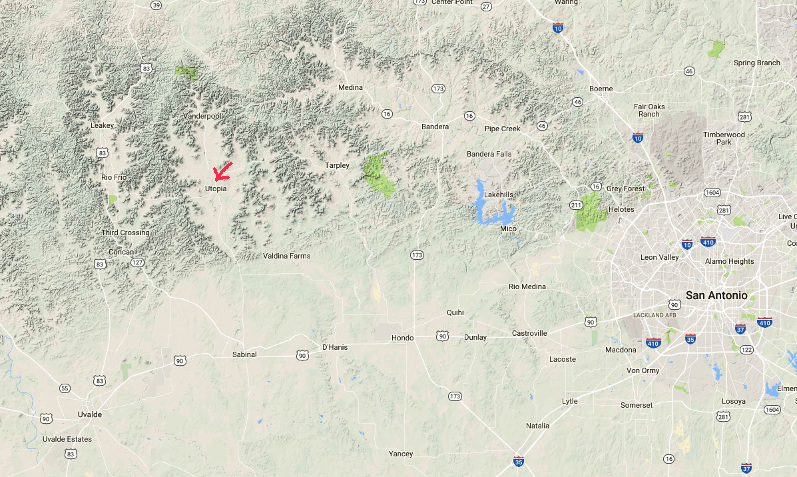
The red arrowish object sorta points towards Utopia. The Sabinal River runs roughly down the center of the
flat valley floor. The Frio River is the next drainage westward. About half way between Hwy 90 and Utopia,
you can see the southern edge of the Balcones Escarpment. Which is the dividing line between the flatlands
of the south Texas brush country, and the hill country of the Edwards Plateau. The darker green above Vanderpool
is Lost Maples SNA at the Sabinal River headwaters.
AREA COVERED - MAPS
Here courtesy of GoogleMaps is an idea of the park and bird list area. Hwy. 187 runs north-south in town. I did not place the pin. Entrance is where Cypress St. hits 1050 at the bend. Note if you extended Broadway west, and Lee Rd. south, the area in that rectangle in northeast corner of the green shaded area is not part of the park or this park bird list. In the natural woods section at northwest corner, the park boundry is a little south of Johnson St., not all the way up to it as shown shaded in green, and it reaches the riverbank adjacent to north end of the island, but does not include the island.
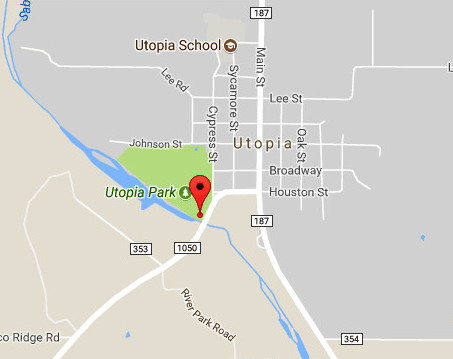
The park area actually extends west to the river bank across from
the north end of the island at upriver end of pond. So generally,
the green shaded area is the area covered, however up to and including
the island, and not the NE corner of pasture as described above.
The northwest-most acre is a natural area of woods with understory.
This Utopia Park bird list covers all of the park property and an acre of the pasture adjacent to entrance road and ball diamond. In general, everything northwest of 1050 including the river, the pond and the island. So from the entrance sign and deco flower garden on 1050, northwest down the entrance road along the river to the spillway and pond, through the big beautiful live-oak motte where the playground and picnic facilities are, and the woods and island at the northwest corner of the park property. But the island is not park property.
Here is a satellite view, courtesy of GoogleEarth:

This was during the drought, in Oct.-Nov., about 3-4 p.m. There is no water running over or below the spillway, the riverbed is dry, mudflats are exposed around the island at the upriver end of pond, the Cypresses are rusty. The main picnic area is under the live-oak canopy center frame. The park boundry is just south of Johnson St., and runs roughly just north of rodeo ring (oval) to north end of the island, which you probably could walk to when this photo was taken. That is the entrance road coming out of the live-oaks below ball diamond, entrance is 100 yards to right or east.
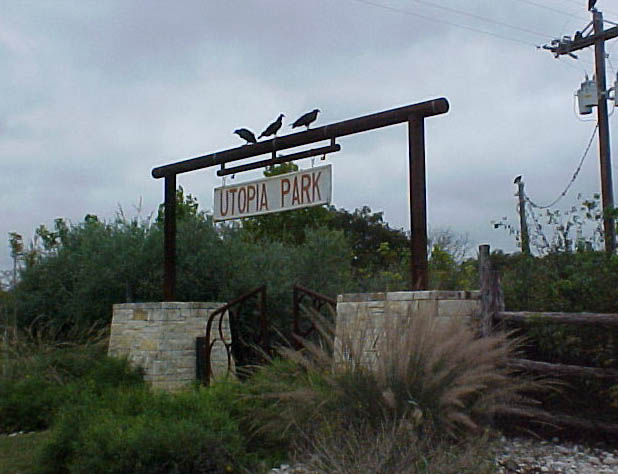
Entrance at Utopia Park, the welcoming vultures might not be there.
HISTORY & PHYSICAL
The park is somewhere in the neighborhood of 29°36'45.2"N x 99°31" 46.7'W per the GoogleMaps pin at the park web page (above). But which differs from some other latilongs I have seen. A pin I placed on a NOAA satellite image showed 29.61° x N 99.53°W (Elev. 1348 ft). Your mileage may vary. You should be able to find it, I did, without any numbers or a map. ;) Elevation of the road at the spillway or dam that creates the pond is 1350'.
Utopia Park sits along the east bank of the Sabinal River (Sabinal means Cypress). In many parts of the country, based on size and volume the river would be considered a creek. It can go dry in droughts. In 1929 the park property was donated to the community by the Kincheloe family (along with the town square park property). Heroes with tremendous amounts of community spirit, generosity, and foresight. It is managed by the Utopia Park Board. The dam and spillway that makes the pond was first built in 1956, then partially rebuilt, extended, and strengthend in 1958 per locals.
Total acreage is under twenty, park proper tax paperwork says 13 acres. Surely the pond is not included in that since that would be in the waterway. The pond is probably about 2-3 acres depending on how far upriver you measure, and apparently has an official name of Utopia Park Lake according to Mr. Google Z. Earth. For checklist purposes, figure 13 acres plus the pond and island in the river (3 ac.?), plus an acre of pasture along north side of entrance road. We can safely call the checklist area of coverage less than twenty acres. Probably very near 17 total. Of which about 3 of those acres are the ball diamond, rodeo ring, and parking area, so not of any birding value. Probably about 15 acres produced all the bird records included here.
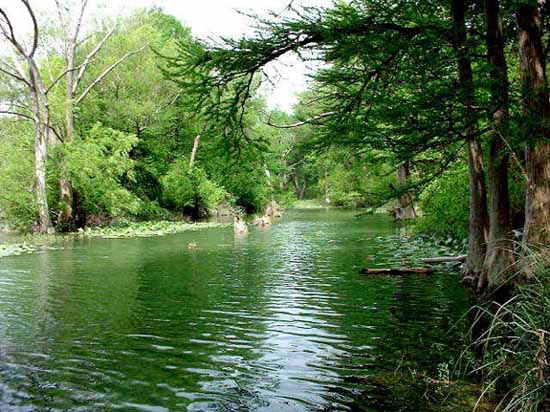
The island is the trees on left, the main river channel is to the left of
that out of view. This is the swampy backwater channel with Water Lillies,
in a natural woodland with understory. The east riverbank and natural
area woods is on right.
PARK BASICS
In full disclosure, I will confess to falling in love with Utopia Park at first sight, and I have no financial interest whatsoever in it. It has all of the standard basic park amenities one expects in a small rural Texas community park: a rodeo ring, a baseball field, a large picnic area in an ancient live-oak motte, an outdoor dance floor, restrooms, and various other facilities and features. Perhaps the biggest draw however is the riverine pond. Which is mostly used for fishing, tubing, swimming and kayaking. And when no human disturbance, by birds. Being riverside the park is naturally air-conditioned in summer and can be 10 to 15dF cooler than hot spots in the local area. Jump in the river and you'll be 25dF cooler than the hot spots (check and make sure it has water first). It is a cold spot in winter as well, often 10-15dF colder than open areas locally. In fact early in the morning in winter the birds are often elsewhere, look in adjacent open warmer areas, they move into the park later after it warms.
OK, so that is the 101 primer on the place and area, now about the birds there...
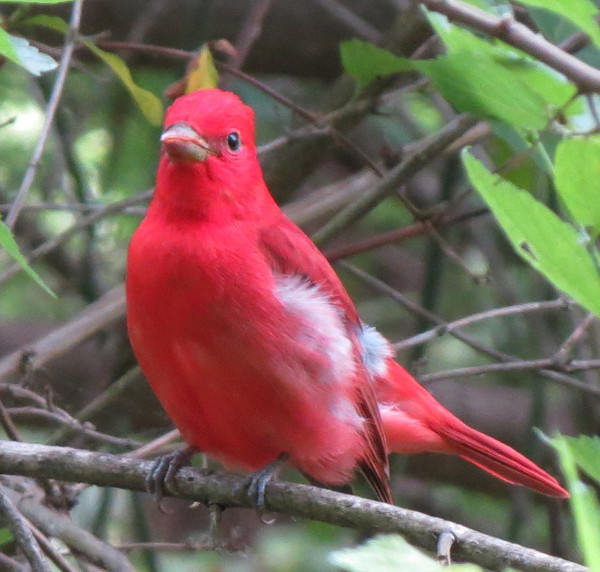
Summer Tanager - male
BIRD DIVERSITY
Bird diversity is a great measure of biodiversity. Lots of diversity means a complex and healthy ecosystem. There are 270 species of birds listed here, known from this Utopia Park area of less than 20 acres. This is a quarter of all the birds known (including accidentals) from all of North America, from Alaska to Florida, Newfoundland to San Diego. In less than twenty acres. It is A THIRD of the *regularly occurring* species. No single place *of as few acres* in the upper Sabinal River drainage, and likely the entire southern Edwards Plateau, maybe in our or any neighboring county, has anywhere near this level of bird diversity in about 15 acres. To put 270 species in about 15 acres in perspective let's consider some other local site and area species totals I found in e-bird, where many birders log their sightings and can give a good snapshot of this sort of thing in well-birded locations.
First, as a point of reference, the great Roy Heideman hard copy Birds of Lost Maples SNA park bird list of 2002 had under 220 species listed (213+-). Now, currently (Oct. 2017) at e-bird, Lost Maples shows 254 species listed. It is over *a hundred times larger* at 2000+ acres, and has 35 years and tens of thousands of observers and hours of coverage. Garner St. Pk. is another nearby popular birding area with tons (comparatively) of coverage, also for decades, also *a hundred times larger* (ca. 1800 ac.) than Utopia Park, has about 207 or so species listed last I saw a total in e-bird (Oct. 2017). For Real Co., the whole county, e-bird shows about 250 species (249).
In other words you can see more species of birds standing in Utopia Park, than you can covering all of Real County, which is thousands of times bigger. Garner and Maples have armies of birders covering them. They hiked thousands of miles up and down rocky hills and canyons, and all of them put together can't find as many species at either place as a dummy standing around at Utopia Park. I could have been holding a martini the whole time, as long as it was not in a martini glass. I would hardly ever had to have said "hold my beer" - in a non-ID'able container of course.
Hopefully this gives an idea of the magnitude of the "bird species diversity for size of area" factor at Utopia Park. Lost Maples and Garner are considered world-class outstanding precious natural resources for their natural history values. Rightly so. So what does having greater bird diversity in one one-hundredth the area say about Utopia Park? Its natural history values are tremendous. I would not be surprised to find that Utopia Park's butterfly and dragonfly lists are larger too. They are surely comparable, again, in one hundredth of the area.
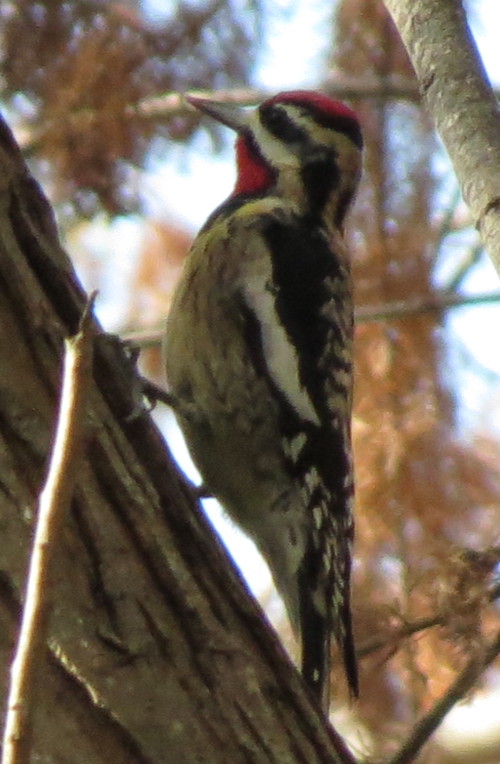
Yellow-bellied Sapsucker, male, in the natural area woods
METHODS
Some few records are sightings of others when known and credible. If you have a sighting from the park of something that is not on the list, please send details, my e-mail is below. Surely lots of species have occurred that I don't know about. In attempting to research everything I can find on birds in the area, there do not seem to be many crumbs of prior published record or specific mention of the site related to bird records. If you know of any I would appreciate the pointer.
Most of this list is from my now 18 and counting years of mostly once or twice, sometimes thrice (sometimes more), weekly lookabouts when I come into town, which began in November 2003. Which are usually about a half hour if slow, but can be well over an hour if any action, sometimes well over two during brief flurries of excitement. So nothing one could call thorough or heavy coverage, but, consistently some, over an extended period of time. Which I think makes for a far more accurate and complete list, than lots of coverage, briefly. Especially where you have boom or bust hydrological cycles. The differences between the first 5 wet years cycle, and the subsequent 7 years of exceptional drought were, exceptional, for birds, butterflies, and dragonflies. A couple year survey in either period would leave you with very different results, and you would be missing a lot of the whole story and big picture.

Here is a Green Jay at Utopia Park Nov. 8, 2020. They can
be surprisingly easy to overlook, especially when silent.
It was species #270 for the park list. There were at
least four, probably six that day. Two were heard
across the river from park on Nov. 11.
The site has apparently not had any prior serious attempt to study, catalog, and document its natural history. So it is getting a lot of coverage compared to what it otherwise gets or has had. The primarily spring (mid-March to mid-June) brief stops by visiting birders was most of the serious looking it received before. I made many hundreds of visits, and spent hundreds of hours looking, probably 1500 at minimum, likely many more. Checking it almost every week of the year for over now eighteen plus years, usually more than once a week. Roughly an hour or two a week on average as an estimate. In spring and fall often lots more though. However, if I lived in town it would have received hundreds more visits and hours and I have no doubt the list would be at least 10% larger than it is, at minimum.
Many dozens of photos of birds at the park are scattered throughout this website on its various pages. Details of many bird sightings there (as well as butterflies and odes) litter the eighteen years of bird news pages, which are all archived (link below) and kinda sorta easily accessible in case the reader wants to investigate further.
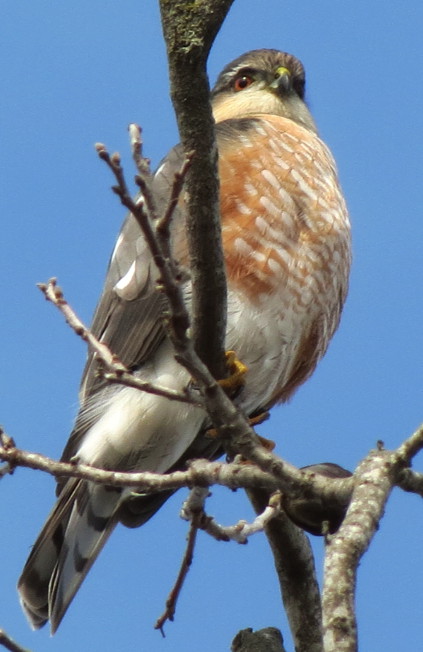
Sharp-shinned Hawk, adult male - this is usually the little
one that grabs sparrows or Cardinals around your house.
BIRDING
Usually you only see a few of the regular expected resident birds. But which is a nice selection of a dozen or two of the local residents. Regardless of season it often includes things like a Ringed or Green Kingfisher, Zone-tailed Hawk, Golden-fronted Woodpecker, the two Carolinas (wren and chickadee), Black-crested Titmouse, Blue Jay, N. Cardinal, Eastern Phoebe, and Barred Owl. During nesting season (roughly late March to August) add a neat set of breeders like Yellow-throated and White-eyed Vireo, Yellow-throated Warbler, Summer Tanager, and others.
In spring migration the place can really rock, or it can be dead. Usually weather is the main deciding factor. Bad weather means good birds, it knocks migrants down. Good weather can mean no birds, they keep going. In migration periods turnover can be fast. Lots of migrants move through quickly. Some of the birds on the list I watched move by in a minute, like the singing male Black-throated Blue Warbler. This sort of thing is going on all the time during migration periods. They grab some bugs, drink and bathe, sing a few bars, and continue on their way. Some aerial migrants like White Pelican, Franklin's Gull, and Mississippi Kite just pass over on their way north. If you are not looking up when they do, you will not likely see one.
For less aerial migrants, it is crucial habitats like this exist for them to succesfully migrate. Rest and refuel sites are as important as breeding and wintering grounds. For some reason(s) Utopia Park is extraordinarily attractive to the full range of habitat preference choices made by migrating birds, as evidenced by the incredible species diversity. Everything that goes by obviously thinks it will be a great rest and refuel site.

Just over 4" and just under a quarter ounce, of pure energy.
Ruby-crowned Kinglet at Utopia Park
There are several factors that synergize into tremendous diversity. One of the factors for the incredible assortment of species seen is simply geographic location. Utopia is in the twilight zone (whooda thunk?) as Roger Tory Petersen described the Edwards Plateau, where east meets west for many species. It is near the eastern end of many western species ranges, and the western end of many eastern species ranges. So we get both. Then too, it is on the edge of sub-tropical south Texas. The river drainages along the southern edge of the Balcones Escarpment, canyonlands as they are called locally, have fingers of south Texas brush country (habitat corridors) that extend up into the hill country along them. As along the Nueces, Frio, and ours the Sabinal, River drainages. So there are some brush-country, and hill-country species from each habitat or biome living in close proximity, as in nearly side by side. Added together the eastern, western, and sub-tropical elements, plus the brush country and hill country aspects, equal a very rich species diversity.
The sub-tropical component is impressive with many south Texas or Mexican species having occurred: Green Jay (!), Audubon's Oriole, Olive Sparrow, Long-billed Thrasher, White-tipped Dove, Great Kiskadee, Couch's Kingbird (has nested and wintered), Clay-colored Thrush (formerly C-c Robin), Tropical Parula, Short-tailed, Roadside, and Gray Hawks. Then there is a big eastern component with things like American Woodcock, Anhinga, Purple Galinule, Kentucky, Connecticut and Black-throated Blue Warbler, Sedge Wren, Wood Thrush and Veery, nesting Yellow-throated Warbler and Yellow-throated Vireo, and many others. The west is represented by things like MacGillivray's and Townsend's Warbler, Pacific and Canyon Wren, Hammond's Flycatcher, Violet-green Swallow, Western Tanager, the occasional Scrub-Jay or Scott's Oriole, Brewer's Sparrow, or Varied Bunting, and Zone-tailed Hawk nests very nearby. Utopia Park is one of those 'anything-can-happen' birding places. You can see eastern, western, and Mexican birds, all in one spot. It has good geography.
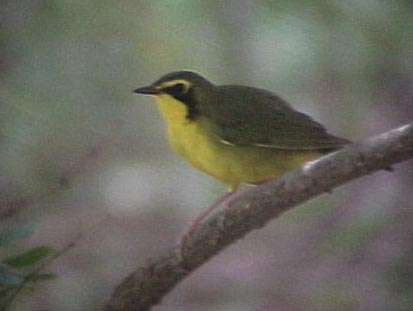
Kentucky Warbler at Utopia Pk., fall adult male,
present August 9-18, 2009. (taken through binocs)
My best warbler day there was May 2, 2011 when a late season drizzly cold cold front with strong northerlies dropped a fallout at the park with 20 species of warblers. On average though you will not find 10 warbler species on a good day in spring, anything over that you did very well. There are however 35 species of warblers on the park list now (counting Audubon's and Myrtle as seperate species). All have been seen in an area in the park of less than 5 acres (in the northwest-end natural area). Which is astounding, and shows the value of natural habitat with an understory. I have had a couple good ones get away too. I do not include what I consider hypothetical sightings on this list, though I will mention the Swainson's Warbler that got away on the island.
Besides 35 species of warblers, a few of the other family group species totals are remarkable as well. Twenty-one species of flycatchers is amazing. Six species of orioles is all of them. The nine species of swallows and martins is actually above the legal limit. Eight species of wrens is excellent, all but overdue Rock. Ten thrushes is a good showing. The nine species of vireos is great, and will eventually add a stray Plumbeous or Black-capped, heck maybe even a Yellow-green (don't laugh, I had one singing at Sabinal July 2, 2005, just 20 miles downriver).
It is a tremendous diversity of species (each makes a living a different way) that are moving over or through the area, see the habitats at Utopia Park, and think "that's the spot!" Just like I did. The first ever known overwintering on the Edwards Plateau of Louisiana Waterthrush and Black-and-white Warbler, were individuals that each returned to Utopia Park for multiple winters. The waterthrush was one of the first ever photographed irrefutably in winter in the whole state.
In the understory of the natural area woods I have seen dozens of Mourning Warbler, over a dozen Gray-cheeked Thrush. Certainly the most exciting Least Sandpiper I ever saw was the one that flew over the spillway calling whilst I was on it. I almost fell off spinning to see it. I was saved thinking of the headlines: nearly sorta grown man breaks neck falling off spillway to see Least Sandpiper. Surely that Sabine's Gull that was just north up the Sabinal River in Bandera Co. one Sept. a few years ago stopped or circled on its way down-valley. And surely the Roseate Spoonbills seen along the river above and below the park (diff. years) flew over if not stopped, etc., ad. infinitum. We need gamecams so we don't miss anything, because anything could happen there.
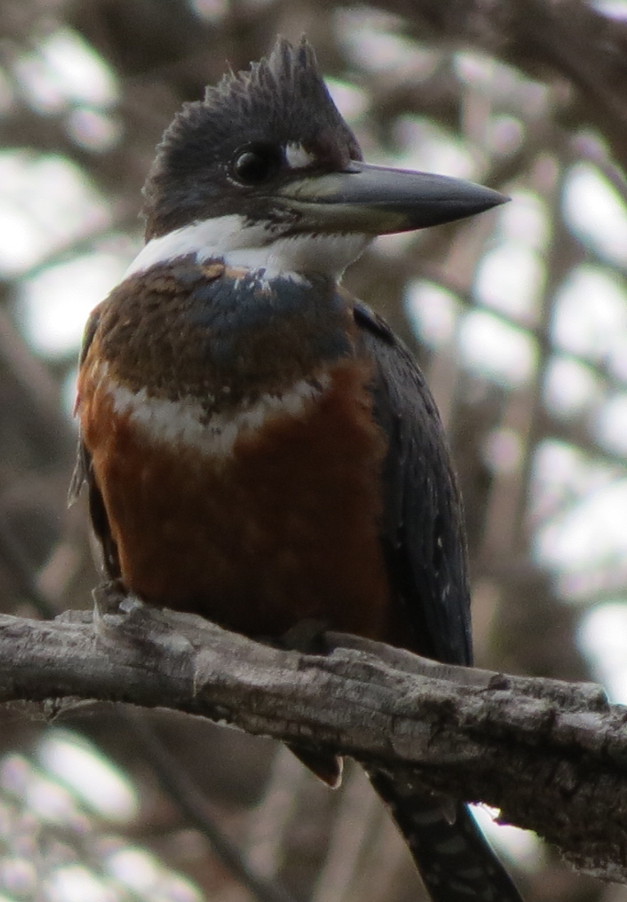
Ringed Kingfisher loves the woodsy backwater area (where this was taken) and breeds
within a mile of the park. Like author it is a habitual park user and repeat offender.
This is a first winter female just less than a year old. I have seen them take 5" Longear Sunfish.
HABITATS
The reason the birding is so good at the park is because there is habitat there. Build or save the habitat and they will come. There are two big main habitat drawing cards. First, the 2-3 acre riverine pond which is visible from the sky to migrating birds, and is *surrounded by trees and vegetation*. To birds, from the sky, it looks like an oasis. Especially compared to all that Juniper or Mesquite they have been passing over. Water and cover = food and shelter, and are key major bird magnets.
It is the only fairly permanent open water of its size for some distance around. Certainly the only with any public access. So it gets a few waterbirds: waterfowl (ducks), long-legged waders (herons, egrets, ibis, etc.), and rarely (mostly in droughts) the odd sandpiper or few. Due to the pond being so small all the aforementioned are often flushed when people are there, so be there early for best bet on them. Further, most of the above occur primarily when there were nocturnal rains during migration periods.
The other most important habitat is the acre or two of fairly sorta natural woodland *with an understory* (the second-growth, shrub and forb layer) at the northwest corner of the park property. It is the only closed-canopy woodland *with understory* with public access locally. The mowed lawn look is nice, but if you want biodiversity, natural habitat including an understory is everything. Just like a hedgerow on a fenceline, you get ten times the biodiversity with an understory. The natural second-growth, shrub, and forb layer gives all the low-to-medium level birds, critters, and bugs a place. When you only have canopy, you do not even get the canopy stuff the same, if, when, and where there is no understory. A canopy does not even function as one other than in looks when there is no understory. Understory is one of the most valuable, and most under-appreciated, cogs in the wheels of an ecosystem. The park miraculously has an outstanding patch of it in the acre or so of the northwest corner in the natural area woods. Which is a veritible island of understory in a sea of mowed grass lawns. So again that truly magic "oasis effect" is at work for all the species that require the natural habitat of canopy with understory. Which is lots.
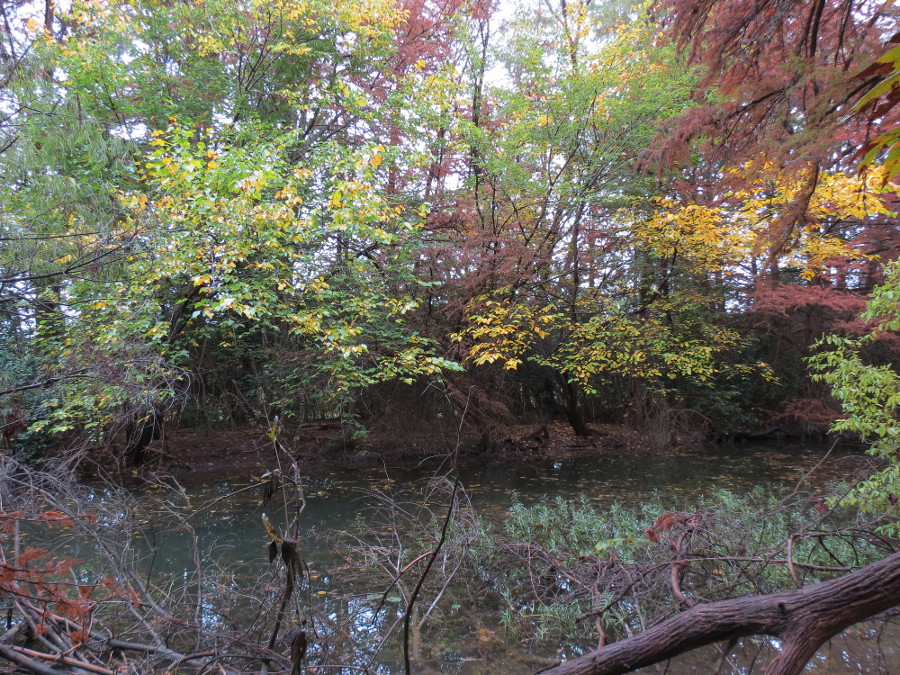
Looking across the backwater channel to island in fall, the yellow is Mulberry, the rusty is Cypress. April-October it is so lush, you can't see into it, here so many leaves have fallen you can see through it.
It is the only piece of riverside natural habitat of closed canopy woods with understory, with public access locally. Many of the birds, butterflies, and dragonflies, occur ONLY in that little tiny acre or two if you count the island. From a natural habitat standpoint, it is priceless and irreplaceable. Not to mention one of those monster ancient 1000 year-old original gotta be 25 foot circumference historical Cypresses sits right in the middle of it. The short path into the natural area woods is on the bank at rivers edge below the screen shelters at north end of picnic area. It might be one of the best little hundred yard birdin' trails in Texas. ;)
So we have two aces with the pond, and adjacent closed-canopy woods with understory, for habitat attraction values. The third ace is physical location. Physical geography is very important, and being part of a river habitat corridor is a major factor that cannot be overstated as to why so many birds go through the park. Migratory birds (and other animals, including butterflies and dragonflies) use river habitat corridors as highways. They are threads of connecting habitat that provide food, cover, and shelter. Safe passage. They are natural funnels for animals on the move. In my opinion the area around the pond and the few acres of fairly natural river corridor woods with understory at the northwest corner of the park (including the wooded island) is the best 10 acre birding spot in the entire upper Sabinal River drainage (Lost Maples to Clayton Grade). Probably would give second place to the ponds area up Can Creek at Lost Maples.
One other factor I think makes another significant enough impact to merit mention. Our fourth ace. The sound of water from the spillway. It must be a din to migrants, like the proverbial sirens sweetly singing. They can hear this waterfall from a mile at least, and probably two when migrating over. Often migrants hit the spillway when shallow (most of the time) for a bath and are gone in a minute, you otherwise likely would not have seen them if you were not standing there watching. The sound of water is a major attractant, particularly for migrants. Birds know there will be food, shelter, and cover around it. We know a single drip attracts birds like magic, put a slow single drip on a birdbath and see the difference it makes. Much less what the water falling over the spillway generates most of the time, a mild roar, that means food, drink, and shelter to them.

American Kestrel at Utopia Park - our smallest falcon at 9-10",
I have seen them suck down a Cotton Rat!
INSECTS
Utopia Park is also great for two of my favorite groups of 'bugs' to study, butterflies and dragonflies. We intend to put up pages with Utopia Park lists for them as well. Counting the sorta new (2012) hill country native plant deco garden at the entrance I have seen about 90 species of butterflies at Utopia Park. Among them, Malachite, Mazan's Scallopwing, Yellow Angled-Sulphur, White Peacock, Crimson Patch (incl. their cats on the Flame Acanthus), Orange-barred Sulphur, White-patched and Sickle-winged Skipper, and many others. Zebra Longwings can be present in multiples (a few at once) up in the woods during years they invade here. Surely I have missed ten if not twenty or more species. The entrance garden has really grown up well, even becoming good bird habitat, and made it so that many more butterflies instead of just passing through fairly briefly, stop and hang around longer to refuel more, for your viewing pleasure. So many more are to be found, ID'd or photo'd. There have been times I walked the garden in peak fall bloom during a good invasion year and saw over 500 individual butterflies of 40 species in 40 minutes. It can be like a butterfly buffet with a smorgasbord of species on a good day, and save a slow birding outing.
For odes (dragonflies and damselflies) my Utopia Park list is about 55 species. Working on a page for them too. An ode pro would have seen a dozen or more species than I have. Some interesting types I have seen include Comet, Cyrano, Blue-eyed, Blue-faced, and Swamp Darners, Ivory-striped and Straw-colored Sylphs, and Slough Amberwing. There is a resident population of Orange-striped Threadtail, which in the U.S. is a central Texas endemic. This is 55 species of odes by an amateur along about 4-500 yards of 'riverside' habitat. The habitats vary from streamish (below the spillway), to riverine pond (above dam), and a great swampy slough (by island). The swampy slough is where the Swamp Darner and Slough Amberwing were. ;) You can ID the habitat by what type of dragons show up there. They know good habitat when they see it.
Like birds, the 'bugs' too are represented by incredible species diversity in an amazingly small area. The great diversity of habitats is one key to the tremendous biodiversity present. If you got down on your knees and had a close look, you would see there are a myriad of different niches and micro-habitats, which means lots of biodiversity, for any and every group of animals. I am sure if one studied moths or beetles at the park, the result would be the same. Astonishing diversity in an incredibly small area.
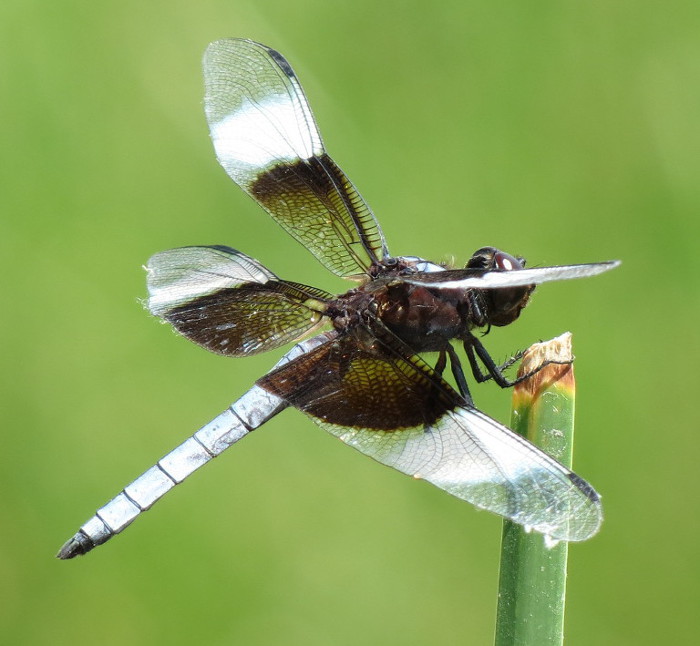
Widow Skimmer dragonfly, male
NATURAL HISTORY
A couple final thoughts on the values of the natural history at Utopia Park. As one can see most of the valley floor area has come under the plow, pig, or goat. That Utopia has a patch of reasonably natural semi-original habitat still preserved, right in town, with public access, I can't commend enough. It reminds me of the old saying about 'we will not be defined by what we create, but by that which we refuse to destroy'. There is tremendous opportunity for further natural history study at the site. I have only scratched the surface of the iceberg, with a few of the most obvious easy-to-see things (yeah I know, the low-hanging fruit). But enough to make one realize Utopia Park is what is called a biodiversity hotspot.
I have recorded in 18 plus years of very part-time looking there, 270 species of birds, 55 species of odes, and 90 species of butterflies, in about fifteen acres. Which means there has to have been 300 species of birds, 75 species of odes, and over a hundred species of butterflies there in the last twenty years or so. It is astounding, off-the-charts, incredible biodiversity for such a tiny area. It is a precious piece of habitat and a natural history gold mine of an asset and resource.
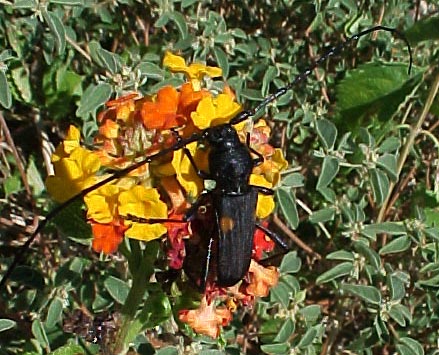
Tragidion coquus, a Longhorn (Cerambycid) Beetle
One neat thing about natural history study is that anyone can make a contribution to what we know through careful observation and documentation. The Longhorn (Cerambycid) Beetle I photo'd (above) at the entrance garden was the first documented in Texas in 50 years per The Bug Guide (since a 1953 Del Rio area record). I have also found first Uvalde Co. dragonfly records at Utopia Park. Some of the birds listed here were also first Uvalde County records, others first Edwards Plateau records. Other sightings helped change our understanding of some species status and distribution in the area (like regular wintering Pine Warblers - not on the maps in the field guides). The long-game goal of natural history study is to increase our understanding of the natural world we live in, through careful observation and documentation (notes, photos, audio, video etc.). Hopefully the tremendous natural history values of Utopia Park will continue to be preserved for others to study and enjoy in the future. It has for me been one of the most fascinating classrooms I ever spent time in. And I have been all over the place, a million miles in over 40 states. Utopia Park is truly a unique gem.
RECENT HISTORICAL PHOTO
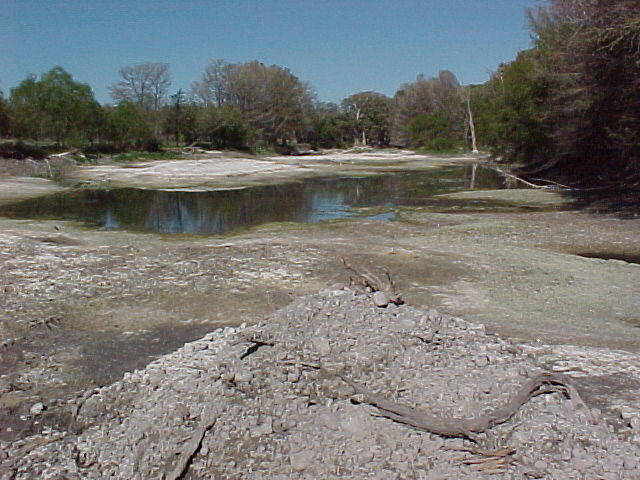
Here is the pond, er puddle, Oct. 15, 2011, looking north, upriver, from out on the spillway. The park is along the riverbank on right. The Cypresses had already turned brown and dropped 'leaves' a month early due to the drought. The pile of rocks and gravel in the foreground is from bulldozing out the debris from the great flood of 2002 which had much-filled the pond. It was cleaned out whilst the river was dry. During the recent exceptional drought it was like this a few years. The ponds and mudflats attracted about five new sandpiper species and a couple new long-legged waders to the site. I was probably the only one in town secretly happy about this. When life gives you mudflats, look for sandpipers.
PARK RULES
Recently the park rules and on-site management have changed. Now it is $10 per person to enter the park seemingly at all times. It used to only be spring to Labor Day. Birding it requires more commitment, bummer for what is usually a half hour or hour stop. It is no charge for Utopia and Vanderpool residents (with proof until they learn your horse, hat, or truck). In the past often birders would give Utopia Park a quick look on the way between Lost Maples and Garner, or, those staying at local lodging would pop in for an hour or so the days they were here. It appears you will have to be a wee bit more committed now. ;) I have been told if you park outside the gate and walk in only, not using picnic tables, pond, you can bird it without paying.

Barred Owl breeds adjacent and is often in the park.
Please do not use tapes to bother it.
Order of bird lists is a real problem since the official order of birds is constantly changing as those that deal with such (taxonomists) have nothing else to do. For a long time most field guides and lists were very similar in order, now offical order resembles none of them as it is changed so often. Since most guides were published they (AOU - American Ornitholigists Union - now AOS) shuffled the deck three times, full 52 card pickup shuffles. We are going to leave the list close to the order of most of the popular fairly semi-recent field guides for now, for ease of finding things. Here the birds are listed fairly close to the taxonomic order of the 7th AOU, with maybe a few of their adjustments after that. Frankly after these last few updates, they need to be slapped with a 20 year morotorium. That should hold me until I die. I have yet to accept their recommendations. They think a texana Scrub-Jay is a Woodhouse's! Pffft! LOLOLOL. On this list the birds are almost all seperately grouped by their proper family groups. Except a few small families were joined in the "assorted cute little things" category.
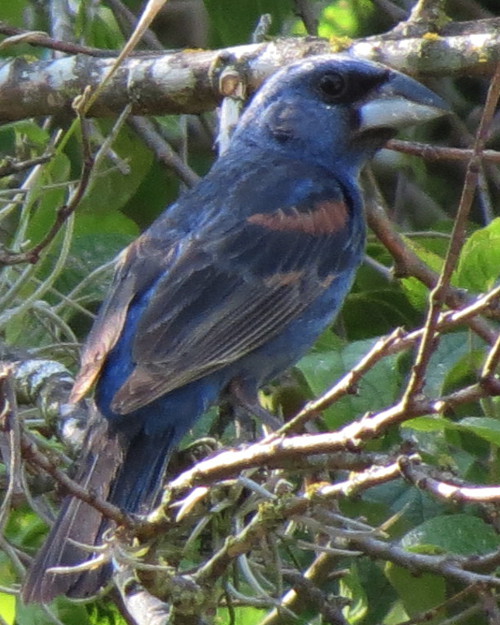
Blue Grosbeak - male
If you've seen a bird species there that is not on the list, please send me some details so we can add it if approved by the Utopia Park Rare Bird Records Committee. Which only requires one yes vote for acceptance. All you have to do is convince one crusty curmudgeon... that hasn't seen whatever it is you are claiming in nearing 2000 hours of looking over 18 years. ;)
My e-mail is mitch AT 'this websites name' DOT com. If you have a super mega rary there try eightthreezero ~ WON ~ 2-3-4-9. Please leave message if no answer. I can be there in ten minutes, maybe less, depending on how good the bird is. Sabine's Gull? Five minutes tops, mostly clothed, and throw yer sardines out to hold the dang bird. I will get you a new can. ;) And, and, I'll throw in a can of smoked oysters.
On the present list, many rare or accidental species have date annotations. I will work on adding more. Meanwhile more detailed documentation for most (maybe all) sightings included in this list can be referenced fairly easily. Go to the Bird News Archive page that covers any date given and there will be more details of the sighting on that date's entry. That is not neccessarily all the documention on any sighting though, particularly for rarities. The archives of the bird news pages are broken into six month increments, so you may have to scroll a little once you get to the one that has the date you are interested in seeing.
Here is the link to the index of bird news archives:
Bird News Archives
Besides the bird news pages, and many other pages at the site, many photos of birds at the park are findable via this link:
Bird Photo Index
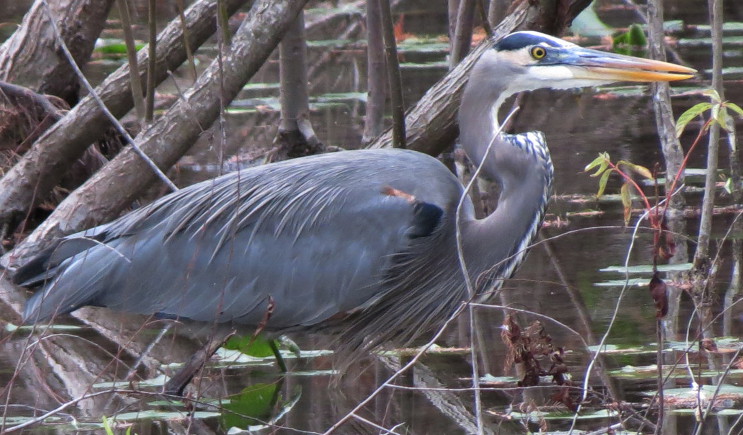
Great Blue Heron at Utopia Park
The bird list consists of all of the known wild birds that have occurred at Utopia Park. After the species name, is an indication of abundance and seasonality, followed by an "N" if it NESTS (breeds) at or immediately adjacent to the site (so park habitats critical to its breeding success). Two n's: "NN" means it NESTS NEARBY. Many of these also use or depend on park resources (food, water) to raise their young. Plus, wandering adults or young might be seen anytime spring to fall. Many species like Barn and Cave Swallow, Purple Martin, Chimney Swift, nest in town but visit the park daily to feed and drink while doing so. If you are not there when they visit, they may be easily missed. Often rare bird records are annotated with dates of sightings. Sometimes additional aspects of a species occurrence may be mentioned in a second italicized line below the main entry. Some species which have multiple subspecies that occur are called out (generally when identifiable) along with which occur and sometimes relative status. Usually this will be in italics below the main species entry. Sometimes what subspecies occurs is in the line item text for a species. Domestic pet farmpond or barnyard birds like Indian Peafowl or Egyptian Goose are not considered, this is a list of wild birds.
ABUNDANCE TERMS
common - usually or often present and findable
uncommon - may be present but in lower numbers; usually one or few at once
occasional - not always present, but it does regularly occur
rare - usually not present, not expected, but does occur, best to document.
very rare - very few records, noteworthy: should document
accidental - seen once or twice; document
~~~~~~~~~~~~
SEASONS
Generally the seasons speak for themselves, but to clarify usage here...
"fall TO spring" - includes winter
"spring TO fall" - includes summer
"winter" - winter species can occur late fall to early spring
"resident" - means some live here year-round
"migrant" = transient - without seasonal modifier means spring OR fall
~~~~~~~~~~~~
ABBREVIATION CODES:
X = Accidental status (capitalized); lower case seasonally (x in winter, etc.)
I = Introduced NON-NATIVE species (4 species)
N = Nests in, around, or adjacent to park (a couple dozen species)
NN = Nests Nearby - so wanderers possible anytime in season (a few dozen species)
LTA = Less Than Annual - occurrence interval for scarcer transients
(ph.) - Photographic record
(a.t.) - Audio Tape obtained
Waterfowl
Black-bellied Whistling-Duck - occasional spring to fall; has nested; N
Greater White-fronted Goose - occasional early spring or scarcer late fall migrant overhead
Wood Duck - occasional to rare, irregular, any season; LTA; (ph.)
Gadwall - occasional migrant or winter (ph.)
American Wigeon - occasional migrant or winter
Mallard - accidental in winter
Blue-winged Teal - uncommon to occasional migrant (ph.)
Cinnamon Teal - accidental Dec. 10, 2005, Sept. 12, 2009 (ph.)
Northern Shoveler - occasional migrant (ph.)
Northern Pintail - very rare in winter
Green-winged Teal - occasional migrant or winter (ph.)
Redhead - very rare in winter
Ring-necked Duck - occasional migrant or winter (ph.), was very common two winters
Lesser Scaup - very rare in fall, winter
Bufflehead - very rare - four on Nov. 5, 2005, a few spring records (6 ph. Mar. 16, 2018 )
Hooded Merganser - accidental fall migrant
Ruddy Duck - accidental - one on March 21, 2007 (D.Pereksta)
Gamebirds
Wild Turkey - very rare in park; NN
Grebes
Eared Grebe - accidental (2) early January 2018
Pied-billed Grebe - uncommon to occasional in winter, migrant; x in summer; (ph.)
Pelicans, Cormorants, Anhinga
American White Pelican - very rare spring migrant high overhead; two at pond Aug. 25, 2017
Neotropic Cormorant - accidental, adult Jan. 20, 2017
Double-crested Cormorant - rare fall migrant
Anhinga - accidental: male May 4, 2011; fem. ph. Aug. 12, 2020
Long-legged waders
Great Blue Heron - uncommon resident, any season, a few year round; NN
Great Egret - occasional spring, late summer, fall transient (ph.)
Snowy Egret - rare spring or fall migrant (ph.)
Little Blue Heron - occasional to rare in spring and fall (ph.)
Tricolored Heron - accidental: two immatures Aug-Oct. 2009 (ph.)
Cattle Egret - occasional migrant (ph.)
Green Heron - one pair nests (except when river dry) on island, spring to fall; N
Yellow-crowned Night-Heron - rare mostly July-Aug. visitor, barely LTA (ph.)
Black-crowned Night-Heron - accidental Sept. 14, 2018 (ph.)
White-faced Ibis - accidental migrant, ten on May 1, 2013
Vultures
Black Vulture - common resident; NN
Turkey Vulture - common spring to fall; usually absent mid-Nov. to mid-Feb.; NN
Raptors (diurnal)
Osprey - occasional migrant, once 1 wintered eating stocked trout, outfished whole town
Mississippi Kite - rare spring migrant overhead, x in fall
Northern Harrier - occasional to rare fall to spring out front in pasture
Sharp-shinned Hawk - uncommon fall to spring
Cooper's Hawk - uncommon to occasional any season, few in summer, more in winter; NN
Roadside Hawk - accidental - imm. Jan. 30, Feb. 1 & 8, (+April 10 on Cypress St.) 2015
Gray Hawk - accidental - adult Aug. 14, 2011
Harris's Hawk - very rare mostly fall and winter transient (ph.)
Red-shouldered Hawk - uncommon resident; NN
Broad-winged Hawk - rare in spring, very rare in fall
Short-tailed Hawk - X - ad. April 14, 2012; imm. (ph.) just downriver Sept. 2016
Swainson's Hawk - uncommon mostly spring migrant, rare in fall
Zone-tailed Hawk - uncommon but regular spring to fall, occasional in winter; NN (ph.)
Red-tailed Hawk - occasional (resident fuertesi); E. or W. types very rare in winter; NN
Crested Caracara - occasional resident, mostly flyovers; NN
American Kestrel - uncommon fall to spring (out front)
Merlin - rare fall to spring, mostly in winter (all but one were Prairie richardsoni type)
Peregrine Falcon - very rare migrant high overhead, spring or fall
Rails, Galinules and Coot
Sora - accidental May 14, 2011
Purple Gallinule - accidental - one late April to mid-May 2011 (ph., a.t.)
American Coot - occasional migrant, spring or fall; (ph.), x in winter Jan. 2018
Cranes
Sandhill Crane - uncommon migrant overhead later fall or early spring
Shorebirds
Killdeer - rare to very rare, any season; has NN (at golf course)
Black-necked Stilt - accidental, six on Aug. 14, 2011 (ph.)
American Avocet - accidental, small flock once in fall (ph.)
Greater Yellowlegs - rare to very rare migrant
Lesser Yellowlegs - accidental migrant
Solitary Sandpiper - occasional migrant when usable shoreline available
Spotted Sandpiper - occasional migrant, mostly on spillway (ph.)
Upland Sandpiper - rare fall migrant heard overhead right after dark & at dawn August to early Sept.
Semipalmated Sandpiper - accidental, one July 30, 2011
Western Sandpiper - accidental - flock of 8-9 on July 30, 2011
Least Sandpiper - accidental, one July 30, 2011
Pectoral Sandpiper - accidental in spring
Wilson's (Common) Snipe - rare mostly fall migrant, x in winter
American Woodcock - very rare: Dec. 27, 2005 (ph.); Dec. 15, 2012 - Jan. 2013; Sept. 25-27, 2015, Dec. 4, 2020
Gulls & Terns
Franklin's Gull - very rare spring migrant overhead
Laughing Gull - accidental - one juvenile Aug. 22, 2014
Pigeons and Doves
I - Rock (Feral) Pigeon - very rare in park; NN
I - Eurasian Collared-Dove - rare in park; NN
White-winged Dove - uncommon spring to fall, fewer in winter; N
Mourning Dove - uncommon; N
Inca Dove - very rare in park; NN
Common Ground-Dove - rare in park; NN
White-tipped Dove - rare, a few records, mostly spring and summer
Cuckoos
Yellow-billed Cuckoo - occasional spring migrant, rare early fall; NN
Greater Roadrunner - rare in park (ph.); NN
Owls - I am never there after dark.
Barn Owl - rare; fall to spring might hear after dark over pasture
Eastern Screech-Owl - (mccallii - 'Tex-Mex' Screech-Owl) rare, possibly resident; NN
Great Horned Owl - rare in park; NN
Barred Owl - Pair nests in live-oaks north of park, regular in park; N; (ph.)
*If only the white van people (bird tour groups) would quit blaring tapes for it!
Goatsuckers (nightjars if you prefer)
Common Nighthawk - rare from park at dusk; NN
Lesser Nighthawk - accidental in spring
Chuck-wills-widow - can hear some years at last light April-June; NN; one in woods July 28, 2018
*(Note: some locals call Chuck-wills-widow, "Whip-poor-will", which I have never detected locally)
Swifts
Chimney Swift - uncommon spring to fall; NN (a.t.)
Hummingbirds
Ruby-throated Hummingbird - uncommon mid-Apr.-mid-May; near common late Aug. to early Oct.
Black-chinned Hummingbird - the hummer of summer: common March to late August; N
Rufous Hummingbird - very rare in fall at entrance flower garden
Kingfishers
Ringed Kingfisher - a few locally resident, regular, any season; NN (ph.)
Belted Kingfisher - a few winter along river, uncommon to occasional fall to spring
Green Kingfisher - uncommon resident, regularly present; NN; look for the white collar (ph.)
Woodpeckers
Golden-fronted Woodpecker - uncommon resident; N (a.t.)
Yellow-bellied Sapsucker - occasional fall to spring (ph., a.t.)
Red-naped Sapsucker - rare, LTA, late fall to early spring; (ph.)
Ladder-backed Woodpecker - uncommon resident; N
Downy Woodpecker - rare transient, any season (ph.)
Northern Flicker - uncommon fall to spring
a) "Yellow-shafted" uncommon - most are these
b) "Red-shafted" occasional - some are these: 10%+
*many 'dirty birds' (hybrids) here (10-20%): underwing color not sufficient for ID to type
Flycatchers
Olive-sided Flycatcher - occasional spring and fall migrant
Western Wood-Pewee - accidental Apr. 18, 2008 (ID by breeerr call & sordid plumage)
Eastern Wood-Pewee - uncommon spring to Sept.; attempted nesting once; x on Nov. 11, 2016; NN
Yellow-bellied Flycatcher - rare in May, very rare in fall; LTA
Acadian Flycatcher - rare spring to summer; has been territorial in woods; has NN
Alder Flycatcher - rare migrant in spring, very rare in fall
Willow Flycatcher - uncommon spring or fall migrant (greener eastern type here)
Least Flycatcher - uncommon spring or fall migrant
Hammond's Flycatcher - accidental in winter (Nov. 28, 2010 - Jan. 11, 2011; ph., a.t.)
Cordilleran Flycatcher - accidental Oct. 14, 2020 (ph.)
Black Phoebe - 2003-08 a pair resident nesting, since then (drought) very rare; N
Eastern Phoebe - uncommon resident, many migrants from north invade for winter; N; (ph., a.t.)
Say's Phoebe - very rare in winter out front
Vermilion Flycatcher - occasional, scarce in park, spring to fall; NN
Ash-throated Flycatcher - occasional March to July; NN
Great Crested Flycatcher - uncommon spring, has been territorial (in woods); occasional to Sept.; NN (ph., a.t.)
Brown-crested Flycatcher - uncommon spring to early summer; has been territorial; NN
Great Kiskadee - accidental Feb. 2-3, 2018 (ph.)
Couch's Kingbird - rare any season, has wintered (ph.), has NN (adjacent to park)
Western Kingbird - occasional spring or fall, scarce lately; formerly NN
Eastern Kingbird - rare spring (May) or fall (August) migrant
Scissor-tailed Flycatcher - occasional spring to fall; for years nested in the big pasture pecan; N (a.t.)
Shrikes
Loggerhead Shrike - very rare fall to spring, in pasture along entrance road
Vireos
White-eyed Vireo - common spring to fall; very rare in winter; N (a.t.)
Bell's Vireo - occasional migrant; mostly Aug. to Sept. colorful (E. type) juveniles; NN
Yellow-throated Vireo - uncommon spring and summer; N (a.t.)
Cassin's Vireo - accidental, one Nov. 10, 2009, one spring record
Blue-headed Vireo - uncommon spring or fall migrant; x in winter (ph.)
Hutton's Vireo - occasional any season; NN (ph.)
Warbling Vireo - occasional spring migrant; rare in fall (greener eastern type here)
Philadelphia Vireo - rare but semi-regular migrant in spring (mostly May); LTA
Red-eyed Vireo - occasional spring to fall; NN
Corvids
Blue Jay - uncommon resident, often a couple in woods; NN (ph., a.t.)
Western (now Woodhouse's) Scrub-Jay - rare mostly late summer or fall; NN
The Edwards Plateau Scrub-Jay is subspecies texana; should be full species
Green Jay - accidental Nov. 8, 2020, 4-6 birds (ph.)
Common Raven - uncommon resident; NN
Chihuahuan Raven - accidental, one, once, over ten years ago
Swallows and Martins
Purple Martin - uncommon early spring to late July; NN
Gray-breasted Martin - accidental once
Tree Swallow - very rare fall migrant
No. Rough-winged Swallow - uncommon spring to late summer; NN
Bank Swallow - rare mostly spring migrant, very rare in fall
Cliff Swallow - in nesting years (not every) common spring to late summer; N
- nests under 1050 bridge wet years, dry years rare to absent.
Cave Swallow - uncommon March or Apr. to Oct.; NN (a.t.)
Barn Swallow - uncommon March to Oct.; NN
Violet-green Swallow - accidental April 22, 2012
Assorted cute little things
Carolina Chickadee - uncommon resident; N
Black-crested Titmouse - common resident; N
Red-breasted Nuthatch - very rare in winter, absent most years
Brown Creeper - rare migrant, most in Nov. and Feb.; LTA; (a.t., ph.)
Bushtit - very rare wanderer any season
Wrens
Canyon Wren - X - two records (late summer or fall) in the biggest ancient cypress
Carolina Wren - common resident; N
Bewick's Wren - uncommon resident; N
House Wren - uncommon migrant, rare in winter
Winter Wren - (Eastern) rare fall to early winter, LTA: almost but not every year
Pacific Wren - X - one calling Nov. 1-19, 2006, pre-split but reported to authorities
Sedge Wren - accidental on May 14: in 2008 and 2011
Marsh Wren - rare transient in spring or fall, LTA
Kinglets and Gnatcatcher
Golden-crowned Kinglet - uncommon to occasional fall to spring, barely LTA: not every year
Ruby-crowned Kinglet - common fall to spring, though fewer lately
Blue-gray Gnatcatcher - common migrant spring and fall, very rare mid-May to late June
Thrushes
Mountain Bluebird - accidental - two wintered with bluebird flock out front, Jan 1.+ 2007
Eastern Bluebird - uncommon resident, can be common in winter; N
Townsend's Solitaire - accidental Dec. 29, 2017 to Jan. 6, 2018
Veery - accidental - April 24, 2011
Gray-cheeked Thrush - rare in spring, about every other year, rarely multiples
Swainson's Thrush - occasional spring migrant, rarely multiples (ph.)
Hermit Thrush - occasional winterer - uncommon fall to spring (ph.)
Clay-colored (Robin) Thrush - accidental May 11, 2008, another all of Feb. 2013
American Robin - usually common fall to spring, but not every year, can be scarce, even absent
Wood Thrush - accidental in fall: Sep. 14, 2016; Oct. 25, 2019 (ph.)
Mimids
Gray Catbird - occasional to rare in spring (mid-April to mid-May in Mulberries); rare fall migrant (ph.)
Northern Mockingbird - occasional spring to fall, rarer in winter; NN
Brown Thrasher - very rare in fall or winter
Long-billed Thrasher - very rare - any season; NN
Curve-billed Thrasher - X - one record out front at entrance bushes
Starlings
I - European Starling - uncommon spring to fall on powerlines out front; NN
Pipits
American Pipit - very rare migrant
Waxwings
Cedar Waxwing - common to uncommon winter to spring most years, but not always, none some years
Warblers
Tennessee Warbler - occasional in spring
Orange-crowned Warbler - uncommon fall or spring migrant, rare in winter
* (almost all are eastern celata subsps., a couple orestera have been seen)
Nashville Warbler - common spring and uncommon fall migrant
Northern Parula - rare in spring; x in summer; NN in 2015; nesting attmept 2021; (a.t.)
Tropical Parula - X in winter; nearby spring and summer records on Sabinal River
Yellow Warbler - common spring and uncommon fall migrant
Chestnut-sided Warbler - rare semi-regular spring migrant; LTA
Magnolia Warbler - rare but semi-regular spring migrant; LTA
Black-throated Blue Warbler - accidental, singing male May 17, 2011
Golden-winged Warbler - accidental, male on April 30, 2021
Yellow-rumped Warbler - common fall to spring
a) "Myrtle" - the default common one
b) "Audubon's" - uncommon migrant, usually 5%, up to 10% of winterers
c) "Myrtubon's" hybrids detected almost annually
Black-throated Gray Warbler - X in spring - plus heard and glimpsed once in fall
Golden-cheeked Warbler - very rare mostly post-breeders in July, far LTA
Black-throated Green Warbler - occasional spring and rare fall migrant
Townsend's Warbler - accidental: male Oct. 27, female Nov. 2, both 2012
Blackburnian Warbler - rare semi-regular spring migrant; LTA; (a.t.)
Yellow-throated Warbler - uncommon late March to early Sept., rare later; x in winter; N; (a.t.)
~ the wintering bird did not sing the local birds song (so not of local origin)
Pine Warbler - rare but regular in late fall and winter
Palm Warbler - accidental in March once
Bay-breasted Warbler - accidental in spring: male and female on May 2, 2011
Black-and-white Warbler - uncommon spring to late summer; x in winter - 5 yr. returnee
~ the wintering female returned several years!
American Redstart - occasional spring migrant; very rare in fall; (a.t.)
Prothonotary Warbler - X in spring
Worm-eating Warbler - X in spring (2011), accidental Sept. 28 2012
Swainson's Warbler - x May 5, 2021 in woods.
Ovenbird - very rare in spring; x in fall, LTA
Northern Waterthrush - uncommon to occasional in spring, rare in fall
Louisiana Waterthrush - occasional migrant with narrow window, one wintered (ph.) returning for 3 years
Kentucky Warbler - very rare in spring, x in fall (Aug. 9-18 ph.)
Connecticut Warbler - accidental twice, on May 19
Mourning Warbler - occasional to uncommon spring (May), and fall (Sept.) migrant
MacGillivray's Warbler - very rare but near annual in spring; x twice in fall
Common Yellowthroat - occasional spring or fall migrant
Hooded Warbler - X - 3 during spring of 2011 starting April 14
Wilson's Warbler - occasional to uncommon migrant, X once wintered
most are likely pusila, a couple orange forehead-lores birds western types (ph.)
Canada Warbler - accidental twice in May; (a.t.)
former warblers
Yellow-breasted Chat - occasional transient; NN
Tanagers:
Summer Tanager - uncommon April to Sept; N
Western Tanager - accidental in spring
Sparrows
Olive Sparrow - rare visitor any season; NN
Spotted Towhee - rare to very rare fall to spring
Cassin's Sparrow - very rare migrant out front, spring and fall sightings
Chipping Sparrow - occasional any season, can be common in winter and spring; NN
Clay-colored Sparrow - can be common but mostly uncommon spring migrant, rare in fall (ph.); (a.t.)
Brewer's Sparrow - very rare to accidental in spring
Field Sparrow - occasional any season; NN
Vesper Sparrow - scarce in park, mostly in pasture, occasional fall to spring
Lark Sparrow - uncommon to occasional spring to fall; rare in winter; NN
Lark Bunting - rare transient, mostly in spring, out front
Savannah Sparrow - uncommon fall to spring fields out front
Grasshopper Sparrow - very rare mostly in spring out front
Fox Sparrow - (Red type) accidental in winter in woods
Song Sparrow - occasional to uncommon later Nov. to Feb.
Lincoln's Sparrow - common migrant, rare in winter
Swamp Sparrow - very rare in fall or winter, LTA
White-throated Sparrow - occasional to rare in winter, spring
White-crowned Sparrow - uncommon to occasional fall to spring
* eastern leucophrys is default type, western Gambell's rare but regular
Dark-eyed Junco - uncommon to occasional fall to spring
a)"Slate-colored" - the default, what almost all are here
b)"Oregon" - rare but semi-regular; LTA
Cardinals, Buntings, and Grosbeaks, etc.
Northern Cardinal - common resident; N
Pyrrhuloxia - very rare in winter out front by entrance
Rose-breasted Grosbeak - rare spring migrant
Black-headed Grosbeak - very rare spring migrant
Blue Grosbeak - uncommon spring to fall; NN
Lazuli Bunting - very rare spring migrant
Indigo Bunting - uncommon spring to fall; NN
Varied Bunting - very rare in spring (twice)
Painted Bunting - occasional spring to fall; NN
Dickcissel - uncommon to occasional migrant spring and fall; some years NN
Icterids: Blackbirds, Orioles, Cowbirds, Grackles, Meadowlarks
Red-winged Blackbird - uncommon spring to fall, rare in winter; has nested, NN
Eastern Meadowlark - rare in winter out front
Western Meadowlark - occasional fall to spring in pasture at entrance
Yellow-headed Blackbird - rare mostly in spring
Rusty Blackbird - very rare to rare in winter
Brewer's Blackbird - common to uncommon fall to spring
Common Grackle - uncommon spring & fall; breeds when island; very rare in winter; N, (ph.)
Great-tailed Grackle - very rare at park spring to fall; has nested in town
Bronzed Cowbird - uncommon spring to summer; rare in fall; N
Brown-headed Cowbird - common spring to summer, uncommon fall, rare winter; N
Orchard Oriole - uncommon (sometimes common) migrant; NN
Hooded Oriole - occasional, spring to fall; NN
Audubon's Oriole - rare resident nearby, most park sightings fall and winter, any season possible
Baltimore Oriole - uncommon migrant spring or fall
Bullock's Oriole - rare migrant
Scott's Oriole - rare visitor, spring, summer and fall records; NN
Finches -
Purple Finch - none in 10 years, formerly regular in winter
House Finch - occasional, mostly flyovers or out front; NN
Pine Siskin - uncommon fall and winter, but not all years
Lesser (Black-backed) Goldfinch - uncommon spring to fall, mostly absent in winter; N
American Goldfinch - uncommon to common mid-late Nov to April
Old World Weaver Finches
I - House Sparrow - some hang now at entrance bushes in winter, rare in park; NN
~ ~ ~ end of Utopia Park species list ~ ~ ~
Listed above are 270 (Nov. 2020) species known from about 15 acres at Utopia Park.
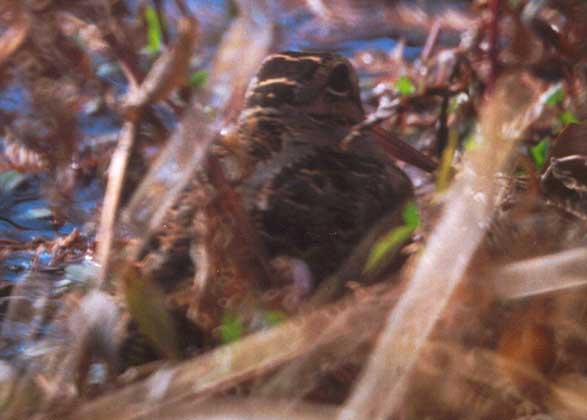
American Woodcock at Utopia Park on Dec. 27, 2005
~ ~ ~
WHAT'S NEXT?
What is missing is another way to put it. Here are some ideas on what I think are the next couple dozen+ "most likely to occur," are, also known as my wish list. They are also the seemingly most overdue and probably happened before anyway birds. Least Grebe, (removed Kiskadee and Green Jay), Rufous-capped Warbler, Groove-billed Ani, Plumbeous Vireo, a few eastern Warblers like Prairie, Blackpoll, Cerulean, Golden-winged (got in '21) or Blue-winged, and a Scarlet Tanager. Also Harris's Sparrow and Green-tailed Towhee (out front seems good for them), and Rock Wren (ought to occur below spillway) are all overdue. For wild card mega-rary vagrants I'd say Piratic or Social Flycatcher. For a little less mega Painted Redstart and Rufous-backed Robin. And ...
Oh Lord, won't you give me
a Ring-billed Gull,
White-breasted Nuthatch
sure would be nice too.
I bird hard all year
tryin' to see what you send,
Oh Lord won't you give me
a Ce-ru-le-an.
(with apologies to Janis J.)
A few things that have been seen within a mile of the park include Harris's Sparrow, Anna's Hummingbird and N. Goshawk in town, a Groove-billed Ani at the north end of town, 4 Green Jay a mile south of town for one whole winter, Prairie Falcon a mile south, and many others I am sure. The Green Violetear in 2016 was just across 1050 at the Sabinal River Lodge. Probably coulda scoped it from the entrance flower garden, shoulda thought of that, but not my style. I am sure I had a Canyon Towhee out front there once but can't find a note or date.
Within a couple miles are records of things like Red Crossbill, White-collared Seedeater, Red-billed Pigeon, Plumbeous Vireo, Black-crowned Night-Heron (got that now), Roseate Spoonbill, Cassin's Finch, Western Bluebird, and resident nearby are Poorwill and Rufous-crowned Sparrow, and many others. Consider too I have over fifteen species not on the park list on our yard list, a couple miles south, at the edge of the river habitat corridor, all of which surely passed through or over the park either coming or going. So getting to 300 is just a matter of observation time. A few nights of listening time during migration could do wonders too.
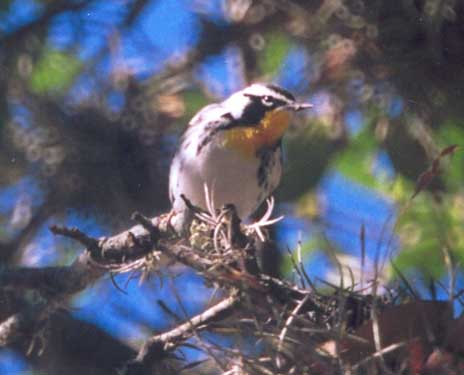
Yellow-throated Warbler nests at Utopia Park, present about mid-March to early or mid- September. Note the different song type of these Ball Moss (Tillandsia recurvata) specialists when you are here. In spring (esp. late), look for the bright orange in lower throat area some here show.
SUMMARY
For bird magnetism, Utopia Park has it all. Water, woods, and understory (habitat) = food, cover, and shelter. Plus the oasis effect on two counts: an open water pond, and understory. The little patch of natural habitat at NW corner is as precious as the pond from a natural history and habitat standpoint. There is certainly nothing like it around, at least with public access. The reality is that if I can see 270 species at the site with just an hour or two looking per week over 18 years (of which I was not there 99% of the time), then surely 300 species have occurred in 15 acres there in the last 20 years.
A couple dozen species nest in or around edges of the park. Another 3 or 4 dozen or so nest nearby and occasionally (some) to daily (many) use park resources to do so. It is likely that over the breeding season more than 60 species are visiting the park, with at least a three or four dozen species depending on it for food or water while raising young. At least a few dozen species are also dependent on it as at least part of their wintering grounds. These are reflections of the biological import and value of the park natural habitats.
I will continue to study the site, and hopefully add more data to the pile. The list will be updated occasionally as needed. One aspect will be adding dates for rare bird records as I dig them up. Also we will post and notify if any important changes occur, as well as work on the ode (dragonfly) and butterfly list pages for the site. Hopefully the digital nature of this will allow easier updates to list, addition of other information, or news of changes at the park. Please feel free to contact me if you have any information you think would add to this work. Meanwhile, I would say if you are in the area, Utopia Park might be worth a look, you never know what you might see there. Please send me a note if anything of interest.
REFERENCES
Blankenship, Lytle H., June Osborne and Sue Wiedenfeld, 2000, Checklist of the Birds of Uvalde Co. (one page self-published - awesome)
Heideman, Roy, 2002, Birds of Lost Maples State Natural Area: a field checklist, TPWD, Austin, Texas
Lockwood, Mark, 2001, Birds of the Texas Hill Country, Univ. of Texas Press, Austin, Texas
Lockwood, Mark, & Brush Freeman, 2003, The TOS Handbook of Texas Birds, Texas A & M Univ. Press, College Station, Texas
Oberholser, H.C., 1974, Bird Life of Texas, Univ. of Texas Press, Austin, Texas
Osborne, June, 2004 (second ed.), Birder's Guide to Concan (and surrounding area), Impress Printers, Waco, Texas
Petersen, Roger Tory, 1960, Field Guide to the Birds of Texas, Houghton Mifflin Co., Boston, Mass.
Web references: clickable hotlinks:
e-bird homepage
The Bug Guide
Ode Central - dragonflies and damselflies
Butterflies and Moths of North America
SEE YA!

Zone-tailed Hawk
THE END ...

Louisiana Waterthrush at Utopia Park
Spring of 2005: park list about 155 for 18 months.
Summer of 2007: park list about 185 for 44 months.
Dec. 2008: Long-billed Thrasher 200th species at UP.
May 1, 2013: 10 White-faced Ibis makes 240.
First, again, the link to the index of old bird news archives:
Bird News Archive
Bird News
Utopia Birds
Birding Sites
Bird Photos
Bird Guide
Reports from Lost Maples
Winter Bird Count
Butterflies
Butterfly Photos
Butterfly News
Rare Butterflies
Moths
Dragonflies
Critters, Bugs, & Stuff
Lost Maples
Garner State Park
Local Site Guide
Home
Our E-mail
 All photographs within this site are copyrighted
All photographs within this site are copyrighted